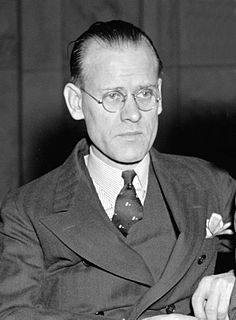
Philo Taylor Farnsworth was an American inventor and television pioneer. He made many crucial contributions to the early development of all-electronic television. He is best known for his 1927 invention of the first fully functional all-electronic image pickup device, the image dissector, as well as the first fully functional and complete all-electronic television system. Farnsworth developed a television system complete with receiver and camera—which he produced commercially through the Farnsworth Television and Radio Corporation from 1938 to 1951, in Fort Wayne, Indiana.
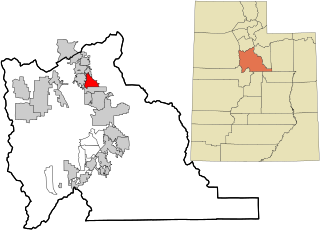
Pleasant Grove, originally named Battle Creek, is a city in Utah County, Utah, United States known as "Utah's City of Trees". It is part of the Provo–Orem Metropolitan Statistical Area. The population was 33,509 at the 2010 Census.
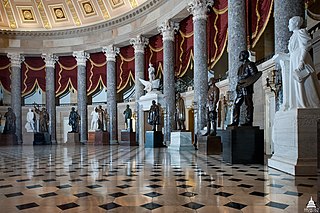
The National Statuary Hall is a chamber in the United States Capitol devoted to sculptures of prominent Americans. The hall, also known as the Old Hall of the House, is a large, two-story, semicircular room with a second story gallery along the curved perimeter. It is located immediately south of the Rotunda. The meeting place of the U.S. House of Representatives for nearly 50 years (1807–1857), after a few years of disuse in 1864 it was repurposed as a statuary hall; this is when the National Statuary Hall Collection was established. By 1933 the collection had outgrown this single room, and a number of statues are placed elsewhere within the Capitol.

The National Statuary Hall Collection in the United States Capitol is composed of statues donated by individual states to honor persons notable in their history. Limited to two statues per state, the collection was originally set up in the old Hall of the House of Representatives, which was then renamed National Statuary Hall. The expanding collection has since been spread throughout the Capitol and its Visitor's Center.

An image dissector, also called a dissector tube, is a video camera tube in which photocathode emissions create an "electron image" which is then scanned to produce an electrical signal representing the visual image. The term may apply specifically to a dissector tube employing magnetic fields to keep the electron image in focus, and an electron multiplier to scan the electrons. Dissectors were used only briefly in television systems before being replaced by the much more sensitive iconoscope during the 1930s.

The Farnsworth Invention is a stage play by Aaron Sorkin adapted from an unproduced screenplay about Philo Farnsworth's first fully functional and completely all-electronic television system and David Sarnoff, the RCA president who stole the design.

Martha Maria "Mattie" Hughes Cannon was a Utah State Senator, physician, Utah women's rights advocate, suffragist, polygamous wife, and a Welsh-born immigrant to the United States. Her family immigrated to the United States as converts to The Church of Jesus Christ of Latter-day Saints and traveled West to settle in Utah territory with other Saints. She started working at the age of fourteen. At sixteen she enrolled in the University of Deseret, now called the University of Utah, receiving a Bachelors in Chemistry. From there she attended the University of Michigan and received her MD. She became the fourth of six wives in a polygamous marriage to Angus M. Cannon, a prominent Latter-day Saint leader during the anti-polygamy crusade. Cannon exiled herself to Europe so she wouldn't have to testify against her husband. Upon returning to Utah, Cannon worked as a doctor and fought for women's rights. She helped put women enfranchisement into Utah's constitution when it was granted statehood in 1896. On November 3, 1896 Cannon became the first female State Senator elected in the United States, defeating her own husband, who was also on the ballot. Martha Hughes Cannon was the author of Utah sanitation laws and was a founder and member of Utah's first State Board of Health.
James Sante Avati was an American illustrator and paperback cover artist. His father was a professional photographer in New York City. His mother died shortly after his birth. He was raised by his maternal aunt and eventually his father married her. While Jim was still young, his father died and another aunt and uncle helped to raise him in Little Silver, New Jersey, where he grew up. His uncle paid for his education at Princeton University where he obtained a degree in architecture in 1935.

The Utah State Capitol is the house of government for the U.S. state of Utah. The building houses the chambers and offices of the Utah State Legislature, the offices of the Governor, Lieutenant Governor, Attorney General, the State Auditor and their staffs. The capitol is the main building of the Utah State Capitol Complex, which is located on Capitol Hill, overlooking downtown Salt Lake City.

Helen Farnsworth Mears was an American sculptor.

Farnsworth Peak is a peak located on the northern end of the Oquirrh Mountain range, approximately 18 miles (29 km) south west of Salt Lake City, Utah, United States. The mountain is named for Philo Farnsworth, the inventor of the first completely electronic television. It is used mainly for radio and television transmission, but could potentially become part of a ski resort owned by nearby Kennecott Land. On the eastern side of the mountain, the land is completely private, and access is restricted. The peak can be reached by hiking from the Tooele side, which is mostly public land. The Bureau of Land Management land extends from Ridge Peak west to the base of the mountain. Public access to this land is available off SR-36 near Lake Point. Several cattle gates need to be opened and closed, but are access roads to hiking, mountain biking, and horseback riding areas.

Fort Cameron was a United States Military installation, located east of Beaver, Utah.

Brigham Young High School was a private high school in Provo, Utah, United States, first known as Brigham Young Academy (BYA). The school later became attached to Brigham Young University (BYU) with its official name being Brigham Young University High School, and commonly called B Y High. It operated under the Church Educational System of The Church of Jesus Christ of Latter-day Saints.

The National Statuary Hall Collection holds statues donated by each of the United States, portraying notable persons in the histories of the respective states. Displayed in the National Statuary Hall and other parts of the United States Capitol in Washington, D.C., the collection includes two statues from each state, except for Virginia which currently has one, making a total of 99.

Brigham Young is a marble statue by Mahonri Young representing the Mormon religious leader of the same name, installed in the United States Capitol, in Washington D.C., as part of the National Statuary Hall Collection. It is one of two statues donated by the state of Utah, and is unusual in the collection in that Young is portrayed sitting down. The statue was unveiled by Alben William Barkley on June 1, 1950.
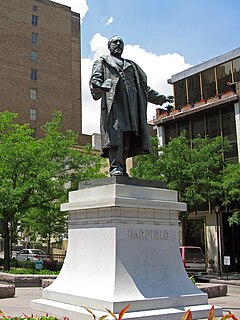
James A. Garfield refers to two different sculptures depicting the American president of the same name by Charles Henry Niehaus. One is installed in Cincinnati, Ohio, and the other is installed at the United States Capitol's rotunda, in Washington, D.C., as part of the National Statuary Hall Collection.

John James Ingalls is a 1905 marble sculpture of the politician of the same name by Charles Henry Niehaus, installed in the United States Capitol, in Washington D.C., as part of the National Statuary Hall Collection. It is one of two statues donated by the state of Kansas. The statue was accepted in the collection by Senator Arthur P. Gorman on January 21, 1905.
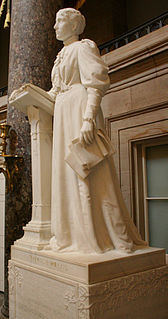
Frances E. Willard is a marble sculpture depicting the American educator, temperance reformer, and women's suffragist of the same name by Helen Farnsworth Mears, installed in the United States Capitol's National Statuary Hall, in Washington, D.C., as part of the National Statuary Hall Collection. The statue was gifted by the U.S. state of Illinois in 1905, making Willard the first woman to be honored in the Collection.
James Shields is an 1893 bronze sculpture of James Shields by Leonard Volk, installed in the United States Capitol, in Washington, D.C., as part of the National Statuary Hall Collection. It is one of two statues donated by the state of Illinois. The sculpture was unveiled by Senator Shelby Moore Cullom of Illinois on December 6, 1893.
Ben Hammond is an American sculptor and painter. His sculpture of Martha Hughes Cannon will represent Utah in the National Statuary Hall Collection in the United States Capitol. The 7 foot, 6 inch statue of Cannon will be molded from bronze and will replace a statue of Philo T. Farnsworth.
















